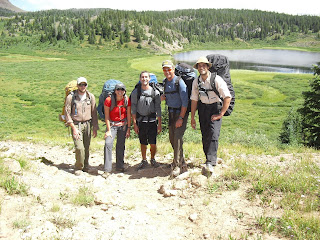To be clear, you can practice these principles in the front country as well as the back country. You can be a responsible car camper just as easily as a responsible trekker. The principles of LNT have no borders and can be practices abroad, in hostels, national parks, even in your own backyard. It's a mentality that we leave a place better than we found it...that's not a bad idea to get behind, right?
Travel and Camp on Durable Surfaces
What is a "durable" surface?- Established trails and campsites
- Rock
- Gravel
- Dry Grasses
- Pine needles
- Snow
(leafy vegetation, mosses and areas without a trail are NOT durable and should therefore be avoided)
* The idea here is that every step you make leaves a mark on the environment. Our footsteps can kill vegetation, destroy habitat, cause erosion and bisect previously untouched areas. We should look for ways to travel that will avoid these negative impacts and make it impossible for others to see where we've been.
I am durable
Good campsites are found, not made
* While we were on our LNT trip, we disassembled numerous fire rings that had been built in previously pristine areas (the ones with all of the aluminum foil scraps were the worst!). Most wilderness areas will have established campsites and if they're available, you should use an area that's already been impacted than create a new impacted space. There's generally no reason to build new sites if you plan ahead but if you have to, find a site that offers the previously mentioned durable surfaces rather than meadow grasses.
I am NOT durable
* It can be terribly alluring to set up your tent on a riverbank but your presence will drive away wildlife as well as potentially contaminate waterways. It becomes extremely tempting to just wash that one dish in the lake or wash your hair in the creek (don't do either of these things by the way, even if you have biodegradable soaps). In addition, banks of waterways are fragile ecosystems and are easily eroded. As a short cut, 200 feet is about 70 adult steps. This is still quite close to the water you were hoping to enjoy but enough space to minimize your presence. In the event that a designated campsite has already been established by a park/nature area, it is better to use it than to create a new campsite but be particularly careful of your impact on the water.
A durable trail system
In Popular Areas:- Make sure you use existing trails and campsites
- Walk in a single-file line and in the middle of the trail to reduce impact
(Don't walk around muddy areas. Plan ahead, wear your boots and gaiters and plow right through them. If everyone walks around the mud hole, it creates a 10' trail where there need only be a 1' path.)
- Keep campsites small and concentrate your activity where impact already exists and where vegetation does not.
I am durable
In Pristine Areas:
- Disperse your group to avoid creating a trail.
If everyone walks next to one another rather than single file, you will be able to look behind you and see no trace of your paths.
- Avoid places where impact is new
I am durable as sand but WAY too close to the water and therefore NOT durable
In summary, let me acknowledge that choosing to be a steward of our wild places means committing to altering your experience. We all want to stay in the most beautiful places and experience the feeling of being the first one to see or touch a place, particularly as our wilderness areas become fewer and farther between. It's time we all commit to the greater good here in keeping those places wild so that we can enjoy them for a very long time. It will never ruin your experience to camp at an established site, just change it a bit. Take a hike to a pristine area rather than camping in one...it will be worth it in the long run.






